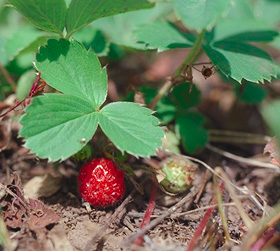How to Grow Strawberries

Learning how to grow strawberries is easy and fun!
Have you ever eaten a summertime sun-ripened strawberry right off the vine? If you have, you know that no store bought strawberry compares in flavor. The strawberry (Fragaria spp.) is an essential part of any home garden or self- sufficient farm. It is one of the only temperate climate fruits that do not grow on a tree or a bush, making it an excellent choice for the apartment gardener as well.
The first thing you as a gardener should ask yourself is "what type of strawberry should I grow?" There are three types of cultivated strawberries that we can choose to grow: June bearing, ever bearing, and day neutral. June bearers are the largest and most common strawberry seen in the grocery stores. They produce over a 2-4 week period in late spring/early summer. Ever bearers produce intermittently throughout the season but produce a smaller fruit. Day neutral varieties produce throughout the season and have smaller berries as well.
How to Grow Strawberries
When establishing a strawberry patch there are a few guidelines to follow. The strawberry produces more in full sun than in partial or full shade. A sandy loam with good drainage is the ideal soil type. The pH of the soil should be slightly to moderately acidic, ranging from 5.8-6.2. DO NOT PLANT strawberries in any soil that housed members of the Solanaceae plant family (tomato, pepper, potato, etc.) in recent years. Verticillium (a fungal plant pathogen) may be present in the soil and give death to the strawberry plants.
Planting the strawberries is fairly simple. They should be planted in the spring or fall. Amend the top few inches of soil with finished compost, and then dig a hole 2-6 inches deep and wide enough to be able to spread the roots of the plant. Cover the roots up to the crown with soil and mulch the top of the soil. Straw is the most commonly used strawberry mulch.
Once the plants are in the ground, it is your goal that will drive the method of production. If you want to grow a lot of juicy fruit, then you will snip runners, water 1-2 inches/week, and force the plants to produce more flowers and berries. If you want to fill in a landscape or garden bed with groundcover and exclude weeds, then you will allow the strawberry plants to run and water only as needed. This latter method is more common for June bearing strawberries as well as wild strawberries (Fragaria vesca, Fragaria chiloensis).
Be More Prepared For Your Next Outdoor Adventure!

Don't leave without knowing these six essential survival skills. Our free survival mini guide reveals the strategies of:
- Shelter & fire to prevent the number one cause of death
- Obtaining clean water to avoid life-threatening dehydration
- Common wild survival foods and other critical skills!

Some common pests a gardener will come across when learning how to grow strawberries are slugs, snails, spittlebugs, and birds. There are many ways to manage these pests. Bird netting will keep birds from eating the berries. Slugs and snails can be caught in beer traps, killed with "sluggo," or fed to ducks.
There are many varieties of strawberries to choose from that will fit different hardiness zones. The varieties that we recommend for the Pacific Northwest are Tri Star (day neutral/ever bearing), Shuksan (June bearing), and wild strawberry (Fragaria vesca).
Learning how to grow strawberries is easy and there is a place in every garden for the only fruit with seeds on its skin. They are wonderful in the perennial vegetable patch near the rhubarb. When they both turn red, you know it is time to make straw-barb jam and rhu-berry pies!
By the way, a big part of why we love homesteading & permaculture skills so much is because they are a natural extension of learning about wilderness survival (both fields are all about self-sufficiency and working with nature to satisfy needs). An understanding of survival not only helps you become a better permaculturist, it empowers you with life-saving outdoor skills to keep you safe when out in nature. Right now you can get a free copy of our mini survival guide here, where you'll discover six key strategies for outdoor emergencies, plus often-overlooked survival tips.
Resources:
Learn more about growing food and self-sufficiency, check out Alderleaf's Permaculture Courses.
For more information on how to grow strawberries check out Mother Earth News.

About the Author: Steve Nicolini is an experienced permaculturist and wilderness skills instructor. He taught at Alderleaf for a number of years. Learn more about Steve Nicolini.
Return from How to Grow Strawberries back to Permaculture Articles
Is The Essential Wilderness Survival Skills Course Right for You? Take the "Online Survival Training Readiness" Quiz
See for yourself if this eye-opening course is a good fit for you. It takes just a few minutes! Get your Survival Training Readiness Score Now!

Grow Your Outdoor Skills! Get monthly updates on new wilderness skills, upcoming courses, and special opportunities. Join the free Alderleaf eNews and as a welcome gift you'll get a copy of our Mini Survival Guide.

 The Six Keys to Survival:
The Six Keys to Survival:
Get a free copy of our survival mini-guide and monthly tips!
Learn more